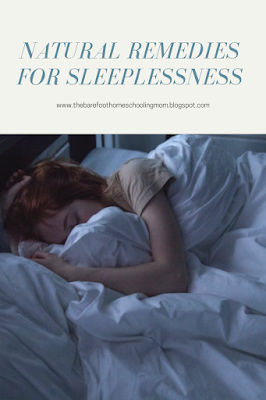I struggled with terrible insomnia for years. It was awful, not sleeping makes you feel so irritable and unhealthy. I tried quite a few over the counter and prescription medications but none worked well for me. They either made me jittery, not sleepy, or made me so sleepy I felt groggy and tired for half of the next day. Several years ago I finally gave up trying different medications to help me sleep and decided to try some natural remedies. I ended up finding several things that helped. In this post I share a few natural remedies for sleeplessness that I have found to be useful.
One of the easiest and fastest ways to raise your magnesium levels is applying a good magnesium lotion before bed.
My favorite magnesium lotion and the one we use most often is Earthley's Good Night Lotion.
Magnesium Lotion
Magnesium deficiency is very common, especially among woman. Magnesium plays an important role in supporting deep restorative sleep. Magnesium is necessary for maintaining healthy neurotransmitter levels including GABA, a neurotransmitter responsible for promoting sleep.One of the easiest and fastest ways to raise your magnesium levels is applying a good magnesium lotion before bed.
My favorite magnesium lotion and the one we use most often is Earthley's Good Night Lotion.
Baths With Epsom Salts
Epsom salts (magnesium sulfate salts) are also useful for raising magnesium levels. Soaking in a hot bath with Epsom salts before bed can be especially relaxing. The hot water relaxes muscles and the salts are absorbed by the body raising magnesium levels and promoting relaxation.
It's also a great opportunity to take a quiet break from life and clear your mind.
Essential Oils
Essential oils are one of my favorite remedies for sleeplessness. They smell amazing and have powerful effects.
There are many oils that have sedative qualities. My personal favorites are lavender and frankincense. I like to apply a couple drops to the underside of my pillow before bed or I add a few drops to a carrier oil (like olive or sweet almond oil) and apply topically about a half hour before bed).
Of all the remedies and medications I've tried for sleep, lavender essential oil has probably been the most effective. It's seriously amazing!
Meditation
One of the reasons I tend to have trouble falling asleep isn't because I'm not tired, I just can't get my brain to slow down. Quiet mediation before bed is an excellent way to relax and clear your mind of all the stress you deal with each day.
I like to set aside just 10-15 minutes to sit somewhere quiet and just concentrate on deep breathing exercises. I keep my focus on my breath and try not to let my mind wander. The peaceful feeling I get from meditation is unlike anything else. It's a great way to get your mind and body ready for sleep.
No Screen Time Before Bed
The blue light emitted from electronic devices like cell phones, TVs, and computers can disrupt our bodies natural sleep cycles if exposed in the couple of hours before bed.
Our bodies natural circadian rhythms are deeply intertwined with the sun. We naturally feel sleepy when it gets dark in the evening and energized when the sun comes up in the morning. Exposure to blue light before bed can trick our bodies into thinking it's daytime instead of nighttime.
No screen time in the two hours before bed can have a profound effect on your ability to fall asleep. Dimming lights around the house in the evening can help too.
What are your favorite remedies for sleeplessness?
If you enjoyed this post, check out:
Follow me on:


This comment has been removed by the author.
ReplyDeleteYour Natural tips and natural tablets for sleeplessness can be very helpful for me to cure my sleeplessness problem. So, thanks for sharing these tips.
ReplyDelete